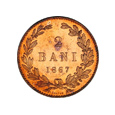Short history
In a report presented by Grigore Tocilescu, the director of the National Museum of Antiquities in Bucharest (MNA), to the minister of cults and public education, regarding a campaign of documentation and requisition of church goods of national value, carried out in August 1885 in Argeș, Râmnicu Vâlcea and Gorj counties, the description of the gospel is also recorded, in the context of the inventory of goods belonging to the Tismana monastery. Thus, at position no. 53, p. 75 / p. 223 of Gr. Tocilescu’s Reports extras we have the following information: ‘A Romanian gospel, printed in Râmnic Bishopric in 1794, with a silver cover, which was part of a manuscript Tetraevangelion. The cover represents on one side the crucifixion: РАСПЄТЇЄ Х’ВО, with the four Evangelists and their consecrated symbols, as well as other Apostles. On the other side, the Assumption of Virgin Mary OУСПЄНЇЄ Б’ЦЄ, with 12 prophets. They are represented in the main picture kneeling with crowns on their heads and in a prayerful position: voievode Io[a]n Mircea and g’dja Kiejna, and all around on both sides, the following inscription is written: ‘To the memory of the pious and Christ Loving voievode Ion Mircea and his Lady Knejna and their sons Ion Petru Vodă, Radulu voievode and Mircea Voeva. Lord, receive the prayer of your faithful servants Pană, Despa, Nicola, Panga, Iani. This Tetraevangelion was made on 11 October 7075 (1566)’. See also the National Antiquities Museum Catalog edited by Gr. Tocilescu, according to the bibliographic references at the end of our study.
As stated at the end of the report sent to the ministry, Tocilescu highlights the importance of organizing the museum collections, which were supplemented with a significant number of works of art, manuscripts and books, whose preservation for posterity is enssured.
The need for protection and conservation of the historical monuments would be ensured by the Law on preservation of public monuments in 1892. The church reacted violently in response to the State’s right to be informed on the state of conservation of items and public church monuments and their inventory. The Metropolitan Bishop of Moldova, Iosif Naniescu believes that the current law is robbing the churches of their treasures and spreading them around the museums, deeming inventories unnecessary since they are carried out traditionally every time the metropolitan bishop or the abbot is changed. In response, Gr. Tocilescu sees fit to apply the law, because that is: ‘A warranty that the precious items will not be allowed to be consumed by flames, damaged by mold or mice.’ It is true that, after the secularization of monastic estate, more and more places of worship, especially monasteries, were going through tough times. Shortages of all kinds hindered church management and their treasures were in danger, almost on the verge of disappearing. That is why the Romanian State acted on this imminent danger and immediately took steps to safeguard the valuable goods found in the church inventory.
During the above mentioned campaign of documentation and requisition carried out in August 1885, Gr. Tocilescu included the Romanian gospel, printed in the Bishopric of Râmnic in 1794, part of the Tismana monastery’s collection.
Towards the end of the 19th century (August 1885), the manuscript joins the MNA collections, being specially cared for as a result of the actions taken by Gr. Tocilescu, the manager of the museum. A series of ex libris stamps, with the title of the National Museum of Antiquities in Bucharest, prove that, at the end of the 19th century, the religious book joined the MNA collections. Moreover, in the MNIR heritage there are a number of great bibliophile values with this type of ex libris. The Romanian gospel, printed in the Bishopric of Râmnic in 1794, with a medieval encasement, was part of the Romanian Historical Treasure inventory that was taken to Czarist Russia in the summer of 1917 (the last transport), from where it returned, in the communist era (1956), together with some of the historical and archaeological values returned by Moscow, as a result of the good relations between Romania and the USSR at that time, and the religious book entered in the National Museum of Art (MNAR) records for a certain period of time. Along with the official inauguration of MNIR on 9 May 1972, the encased gospel was permanently transferred to the patrimony of the largest museum in the country.
The gospel printed in the Bishopric of Râmnic and its medieval encasement
The holy and divine gospel printed in the Bishopric of Râmnic during the time of Alexandru Constantin Moruzi, in 1794, is exhibit of November 2019 at MNIR. The book is printed in Romanian with Cyrillic alphabet and contains 163 sheets, having typographic decorations: head letters, miniature letters, vignettes, engravings, decorative elements.
Each gospel begins with a brief chronicle of the evangelist‘s life, written by St. Sophronie, then a representation of the evangelist, as a scholar, and the title page with the beginning of the gospel text. In addition, the gospel of John has a brief preface about his life, arranged according to the text of St. Sophronie, written by Dorothei, the bishop of Tire, and the gospel of Mark is preceded by St. Theofilact from Ohrida’s preface about his life, which follows the text of St. Sophronie. At the end of the four gospels, there is a religious calendar or ‘Minologhion’, where the church year begins on 1 September and ends on 31 August, each saint having its importance within the Sinaxar.
The term gospel is translated from the Greek phrase ‘the good news’ (of the coming of the Messiah; Christ). There is also a general meaning, which refers to the actions and teachings of Jesus Christ. The gospel is not to be confused with the Tetraevangelion, even though the texts are the same. In the case of the Gospel, the religious content is grouped differently, the criteria being stated after the listing of the Gospels, after Sundays and holidays throughout the year, and the order is in accordance with the Gospel according to John, to Matthew, to Luke and to Mark. The name Tetraevangelion is also of Greek origin and means ‘four gospels’, namely the four gospels of the New Testament: the Gospel of Matthew, Mark, Luke and John. The Tetraevangelion contains the writings of the evangelists, arranged in the aforementioned order, and can be found in manuscript or printed form.
In the past, after printing, the gospel of 1794 was covered, in the Tismana monastery workshop, in a beautiful medieval case, according to the monastic tradition of preserving encased ornaments (most probably the encasement was shrunk and adapted to the binding needs of a printed gospel). The encasement is in a precarious state of preservation, no longer retains functional closure elements, so that, at present, it is detached from the gospel.
The case originally belonged to a Slavonic Tetraevangelion, of the manuscript type, as mentioned in the circular Slavic inscription on the second cover (a text about the boyar donation from the Pană family, who ordered the Tetraevangelion’s execution, with a term of completion on 11 October 7075 / 1566). One assumes that the Tetraevangelion was given to the Tismana monastery by the commissioner, in memory of the ruler Mircea Cioban and his family, as well as to the eternal remembrance of the boyar Pană and his family, the latter being also ‘supporters’ (regarded as caretakers, secondary founders) of the monastery near the yew forests. Over time, because of difficult times and destruction, the manuscript was lost, remaining just the case, which, after 1794, will cover the gospel printed in the Bishopric of Râmnic.
In order to withstand time patina and other degradation factors, the cult manuscripts were usually bound in wooden plates, usually covered in precious metal plates, decorated, in turn, by stamping, engraving, carving or hammering, with different ornamental motifs, geometric and vegetal, with religious scenes and figures of saints, with short liturgical or votive inscriptions, with inlaid enamels and precious stones. Thus worked, these cases acquired the attributes of authentic works of art. The damage usually affected the manuscript support, the bonds lasting over time, but there are situations in which the gold and silver cases were intentionally detached from the manuscripts, due to the precious metal. Most of the times, the cases were sold as such or were melted and turned into various ornaments.
The old encasements in the church collections were sacred relics, being valued according to the needs and necessities of the community, without losing anything of the original function of these works of art. Nowadays we find some copies of printed religious books, which have medieval encasements. Such a case, perhaps the most well-known in the MNIR, is of the case with cabochons from the time of Stephen the Great. The binding is original, made of wood covered with two plates of gilded silver and rock crystal cabochons, fixed in a frame of the case. The plates of the case are connected to each other by rings with granulations mounted on metal links. The case originally adorned a manuscript from the time of Stephen the Great, of which we know nothing at present, due to the fact that the manuscript was stripped of its precious binding. The case presents relief decorated and engraved elements, with religious scenes and thematic inscriptions, placed in the frontispiece. On the front cover of the encasement there is the scene ‘Descent of Jesus to Hell’ (Resurrection) or ‘Anastasis’, according to the Byzantine tradition, and on the back cover is the scene ‘The Assumption of the Virgin Mary’. Both religious scenes are framed by floral motifs, with a plus for the back cover, which is decorated with four rock crystal cabochons. The encasement resembles that of 1487 from Humor and that of 1507, the last two being kept in the museum of the Putna monastery. At present, the case covers a gospel of Greek writing, printed in Venice in 1799.
Returning to the encasement of the Tismana monastery in 1566, one important aspect must be also considered. The previous cover, which presents in the center the canonical scene “The Crucifixion of the Lord”, displays in flanks six marginal medallions with apostolic figures. On the other hand, the back cover, where the “Assumption of the Virgin Mary” scene is noted, has six medallions on the two vertical lines, representing the busts of the messianic prophets. Similarly suggestive is the representation of the ruler Mircea Ciobanul and Lady Chiajna, kneeling around the Tree of Life, crowned and dressed in a Byzantine manner, reminiscent of the votive portraits of the Bulgarian tsar Ioan Alexandru‘s family, found in the famous Tetraevangelion in London (“without equal in all Levant” and inspiration for Suceviţa Tetraevangelion 23), which traveled through Moldova and Wallachia, after Bulgaria’s fall under the Ottoman occupation, before being repurchased from the “St. Paul” monastery on the Athos mountain, where it had probably been donated by the Movileşti, by Lord Robert Curzon, a great traveler and English collector.




















